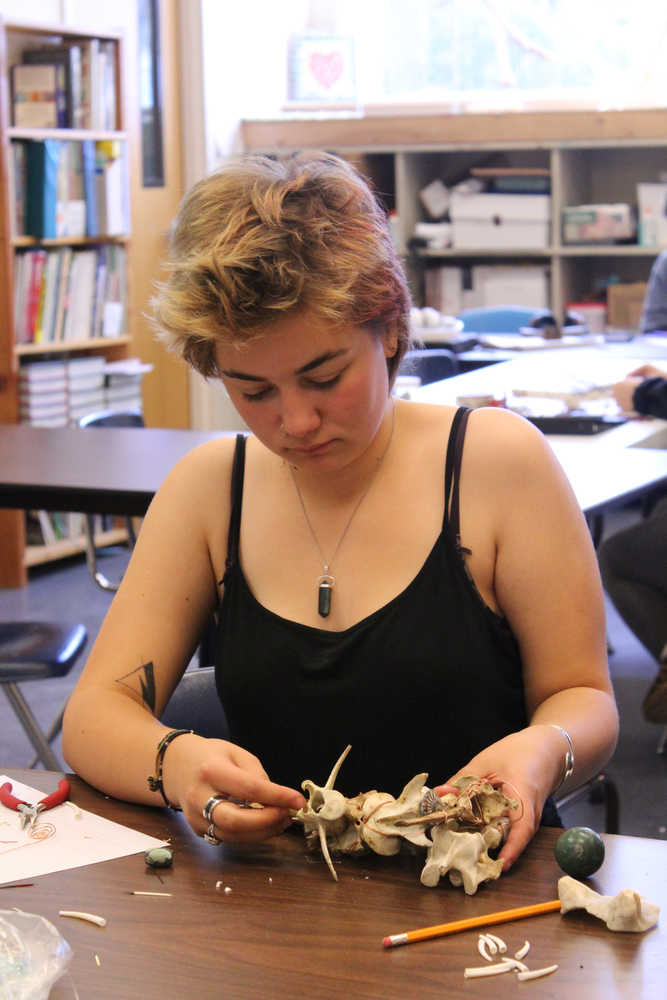Bones, feathers, porcupine needles, beads and other items covered the tables of Homer Flex’s workshop area as students and staff drilled, threaded and attached components of their art pieces. Melissa Shaginoff, the Kenai-raised artist facilitating the Sept. 8-9 “Objects of Importance” workshop, moved throughout the room and offered aid to anyone with questions.
The 28-year-old artist recently returned from the Sheldon Jackson Museum Native Artist Residency in Sitka. She received her bachelor of fine arts degree in studio art from the Institute of American Indian Arts and Alaska Native Cultures in Santa Fe, N.M. She also holds a bachelor of arts degree in psychology from University of Alaska Anchorage and worked as a social worker for three years before pursuing art full time.
Her psychology background often helps her in her work, Shaginoff said.
“It affects my work by allowing me to be insightful and comtemplate my experience in the world,” Shaginoff said. “I can figure out how perspectives are formed and it’s helped me want to engage with people.”
Though this workshop was Shaginoff’s first time teaching with the Artist in the Schools program, Homer Flex students get a taste of different art mediums through their curriculum each year.
“We try to incorporate different artistic expression in our classes: ceramics, sometimes we’ll get woodworking, and we’ll do a second artist in the school in the later part of the year,” said Homer Flex Principal Chris Brown. “I think too often with education we simply push the logical thinking side of the brain and there’s a lot of studies out there that look at making connections on both sides of the brain. When you’re thinking with the artistic side, you’re thinking more globally instead of focusing on the details. For us it’s making sure we’re expanding the students’ horizons.”
Senior Justice Steiner brought in a variety of bones that he found in the woods near his home out East End Road and from road kill that his family gets from the game road kill list. Not only were the bones for his use, they also were for friends who had previously started projects using the bones. On the other side of the table he was working on, Cassidy and Sierra Wylde used metal wire to attach bone together to create a holder for a special stone and a sword, respectively.
“We do this every year and different artists come in. … Every year is unique and different. This year is most interesting for me. They really look into the community to find the best aspects,” Steiner said. “I think that it’s influenced a lot of us. Not all kids have this outlet … it’s a resource and everyone’s putting time and energy into it.”
Shaginoff started the workshop off by asking students to bring in an object that held meaning for them. She created the class out of an Athabascan tradition where a young girl has a piece of jewelry as a symbol of a woman’s importance and to protect herself from her power as she transitions into adulthood. Shaginoff, who is of Athabascan and Paiute descent, used the idea of the tradition in her art piece for Bunnell Street Art Center’s exhibit “Decolonizing Alaska,” by creating a portrait of her sister with a necklace made from bone, a syringe and insulin hanging from her neck to represent the type one diabetes Shaginoff was born with.
“My art is indigenous because I’m indigenous, but also a lot of different things. I use indigenous materials because they are important to me,” Shaginoff said.
Shaginoff explained to the students that the art they were to create would be a self-portrait of sorts, representing themselves through something special. As Cassidy Wylde used bones to create a holder for a stone she carries around like a talisman, she contemplated the life the bones she was using represented.
“It’s really interesting to think about how all these things were once living and now being used,” she said.
Homer Flex senior James Carter drilled holes in a slice of antler to create a miniature chair for his six-year-old sister to play with, while Leo Castellani used bone, beads and stone to create a piece with a ring his mother gave him.
Shaginoff did not describe an end goal to the students when the workshop began, but instead spoke about her cultural past and the materials they would work with. Then, she left it up to them.
“I sensed that Flex would be the right place for this,” said Bunnell Street Art Center executive and artistic director Asia Freeman. “I am eager to come back and do a presentation of contemporary sculpture. I think it was a really eager and imaginative student body. They jump right into it. There is a lot of individuality and the arts cultivate that.”
Shaginoff was impressed by how engaged the students at Homer Flex were in her workshop, she said. For Shaginoff, teaching is an important aspect of being an artist, so the opportunity to do so through a workshop sponsored by Bunnell and The CIRI Foundation was exciting.
“Painting only reaches people who go see it. In a school, I reach more people and learn from the conversation that happens when engaging with others,” Shaginoff said.


